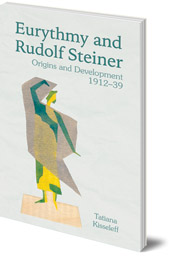Eurythmy and Rudolf Steiner
Origins and Development 1912-39
Quick Look
- A first-hand account of the origins of the eurythmy movement, which reveals its spiritual foundations
- Written by Russian anthroposophist Tatiana Kisseleff, a pioneer for the eurythmy movement and student of Rudolf Steiner
- Available in English for the first time, and fully illustrated with photographs, drawings and facsimile reproductions
An insightful, fully illustrated account of the beginnings of eurythmy from a pioneer of the movement who studied directly under Rudolf Steiner.
Description
In the autumn of 1912, Rudolf Steiner presented the first eurythmy performance. It marked the revival, in modern form, of the sacred art of dance, which had been used in the ancient Mysteries to express the movements of the stars and the planets. In the years that followed, Steiner and his wife, Marie von Sivers, developed eurythmy further, broadening it beyond the artistic to encompass healing and educational elements as well.
One of the pioneers of this new form of movement was the Russian anthroposophist Tatiana Kisseleff, who became a student of Steiner's and later a celebrated eurythmy teacher.
In this remarkable book, available for the first time in English, Kisseleff describes the spiritual foundations of eurythmy as they were explored in Steiner's lectures and recounts the instruction she received from him.
This is both an eyewitness account of the origins of eurythmy and a record of a deeply personal journey of one person's efforts to master it. The book is illustrated throughout with photographs, drawings, facsimile reproductions from notebooks and posters advertising early eurythmy performances, alongside accounts of performances of various pieces including Goethe's Faust and Rudolf Steiner's own Mystery Dramas.
This is a fascinating account for eurythmists and anyone who wants to delve more deeply into eurythmy's history and development.
Reviews
'I have thoroughly enjoyed reading this book and am grateful that it is finally available in the English language, thanks to the initiative of the excellent translator Dorothea Miers.
It offers deep insights into both Eurythmy and Rudolf Steiner, and yet remains an accessible and interesting read... For those who are keen to gain glimpses into the extraordinary spiritual possibilities of the art of Eurythmy, this book is a must.'
-- Gregers Brinch, Peredur Eurythmy, Forest Row
'Tatiana Kisseleff's account of her experiences as one of the first eurythmists is invaluable for anyone practising or teaching eurythmy today. I would highly recommend it to anyone working as a eurythmist or wishing to deepen their insights into the beginnings of both eurythmy and anthroposophy.'
-- Saraphir Legind, Eurythmist and Movement Teacher, UK
'[An] important account by a leading eurythmist... Priceless.'
-- Maren and Alan Stott, West Midlands Eurythmy Association
Author
Tatiana Kisseleff (1881-1970) was born in Warsaw, Poland to Russian parents. She studied law in France and later went to live in Moscow where she met and married the painter Nikolai Kisseleff. The couple became interested in Theosophy, and in 1911 Tatiana met Rudolf Steiner and Marie von Sivers in Hanover, Germany. Although Tatiana's interests lay in social work, Steiner directed her to the art of eurythmy and took her on as a personal student. She studied eurythmy in Berlin before being invited to Dornach in 1914 to teach eurythmy. The rest of her life was devoted to the practice and teaching of eurythmy.
Dorothea Mier was director of Eurythmy Spring Valley, USA, from 1980 to 2005, following many years as a member of the Goetheanum stage group under the direction of Marie Savitch. She is currently active teaching workshops in the US and abroad.

